Natural Treatments For Tendonitis: Symptoms, Causes, & Tips
Soothe the piercing pain with some natural ingredients in the comfort of your home.
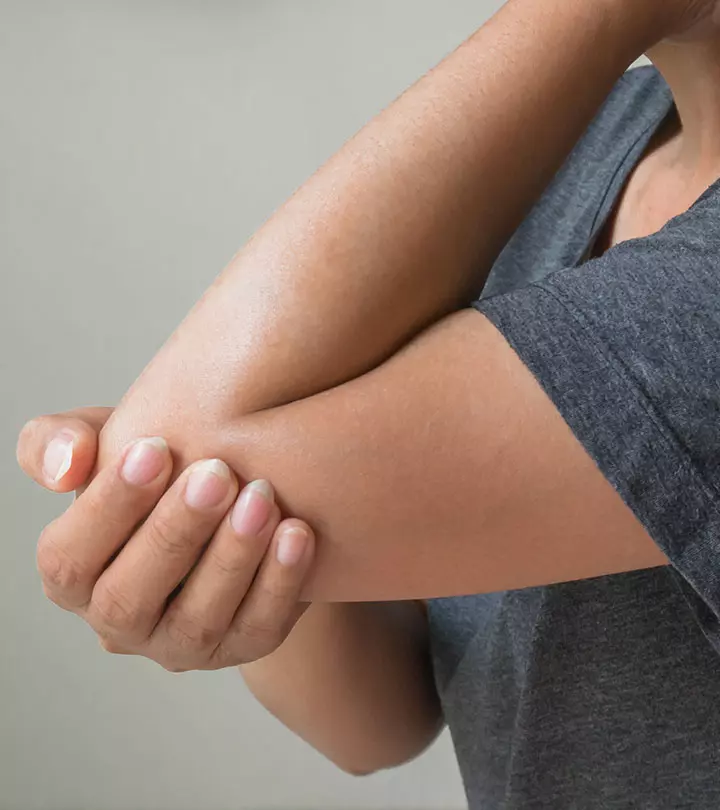
Image: Shutterstock
Tendonitis, or inflammation of your tendons, can happen due to sudden twists and falls. While ointments and painkillers can help you ease the pain, the natural treatments for tendonitis discussed in this article can provide immediate relief. Tendonitis can happen anytime during an intense workout or a sudden sprint, causing severe pain and distress! Therefore, it is important to take proper care to prevent further damage and soreness. These natural home remedies can come to your rescue until you get professional help. Read on to know more.
In This Article
What Is Tendonitis?
Tendonitis is a medical condition that develops as a result of inflammation or irritation of a tendon – a thick cord of collagen tissue that attaches your bone to your muscle
. This condition is also commonly referred to as tendinitis.
Randy Ellefson, a guitarist and blogger, recounted his struggle with tendonitis that resulted from intensive guitar playing during his college years. He wrote, “The tendinitis (also spelled “tendonitis”) silently building in both arms suddenly came to life in August 1996. Temporarily crippled and unable to use my arms, I was unemployed for a year (i).
It can occur as a result of a repetitive but minor impact on the affected area or from serious injury. Wondering which areas of your body are more prone to tendonitis? Let’s find out.
Key Takeaways
- Tendonitis is a condition that causes inflammation of tendons due to injury or sleeping in an incorrect posture.
- Turmeric and ginger tea possess anti-inflammatory and analgesic properties, which can help manage the inflammation and pain.
- Prescribed painkillers, corticosteroid injection, and physical therapy with proper rest also help in treating tendonitis.
- Always warm up before exercising to decrease the risk of injuring your tendons.
Common Areas Affected by Tendonitis
While tendonitis can occur in part of your body where a tendon is connecting your bone to your muscle, it is more likely to occur in the:
- Base of your thumb
- Elbow
- Knee
- Hip
- Shoulder
- Achilles tendon
Tendonitis is classified into different types depending on the different body parts it affects.
Types Of Tendonitis
- Achilles Tendinitis – An injury to the Achilles tendon that may be caused by ill-fitting shoes or sports injuries. Knowing about some home remedies, such as ice packs, castor oil, etc., can help you treat Achilles Tendinitis effectively at the comfort of your home.
- Supraspinatus Tendonitis – It occurs when the tendon around your shoulder joint becomes inflamed.
- Peroneal Tendonitis – Inflammation of the peroneal tendons (located in the legs and ankles).
- Extensor Tendonitis – Inflammation of the extensor tendons located in your hands and feet.
- Patellar Tendonitis – Inflammation due to an injury to the tissues connecting the kneecap to your shin bone (patellar tendon).
- Golfer’s/ Tennis Elbow – Irritation of the tissue that connects your forearm muscle to your elbow. Knowing about Tennis Elbow causes, symptoms, and remedies can further help you tackle this situation better.
- De Quervain’s Stenosing Tenosynovitis – This type of tendinitis results from the inflammation of the sheath that surrounds your thumb tendons, between your thumb and wrist.
- Trigger Finger/Thumb – It is caused by the inflammation of the tendon sheath in your palms.
- Tendonitis Of The Wrist – It is a degenerative condition that affects the tendons of your wrist.
Inflammation of your tendon results in the signs and symptoms listed below.
Signs And Symptoms
The symptoms associated with tendinitis are:
- Pain in the affected and surrounding area: The pain can be gradual or sudden and severe in the presence of calcium deposits.
- Frozen shoulder or adhesive capsulitis: Loss of shoulder motion
- Pain that worsens upon movement
- Crackling or grating of tendons as they move
- Swelling
- Redness
- Development of a lump along the tendon
These symptoms can last anywhere from a few days to several weeks or even months.
Various activities can trigger or even worsen existing cases of tendonitis. They include the following.
Causes And Risk Factors
- Carpentry
- Raking
- Gardening
- Painting
- Shoveling
- Skiing
- Scrubbing
- Tennis
- Golf
Other factors that can increase your risk of developing tendonitis are:
- Sitting or sleeping in an incorrect posture at home or at work
- Not warming up before a strenuous workout or sports
- Medical conditions like rheumatoid arthritisi An autoimmune inflammatory disease that affects the tissue lining on both sides of the joints at once, causing intense pain. , gouti A type of arthritis that occurs when uric acid forms crystals in the joints and is characterized by pain, joint tenderness, and redness. , or psoriatic arthritisi A type of arthritis that affects people with the skin condition psoriasis (a skin disease).
- Overuse of the affected tendon
- Infections from a cat or dog bite
 Trivia
TriviaIf you visit a doctor for your condition, they may ask you to undergo any of the following diagnostic tests to confirm tendonitis.
Diagnosis
To diagnose your condition, your doctor may ask you to:
- Get a physical examination done to look for an injured tendon.
- Get an X-ray to look for calcium deposition that will help confirm the diagnosis.
- Take other imaging tests like an ultrasound or MRI scan to look for swelling.
Once your diagnosis is confirmed, you may start looking for ways to alleviate your symptoms. Treatment will help in combating tendonitis faster and preventing your symptoms from worsening.
Before looking at the medical options to treat your condition, why not have a look at some natural treatments for tendonitis that are as effective but with fewer side effects? Keep scrolling!
Note: The first line of treatment for acute tendonitis should be RICE. R – Rest, I – Ice, C – Compresion, E – Elevation of the joint.
Natural Treatments For Tendonitis
- Epsom Salt
- Apple Cider Vinegar
- Ice Packs
- Bone Broth
- Cayenne Pepper
- Vitamin
- Ginger
- Castor Oil
- Turmeric
Home Remedies To Treat Tendonitis
Since tendonitis occurs due to inflammation of a tendon, all you need to do is manage inflammation to alleviate its symptoms. From Epsom salt to ice packs and turmeric, numerous home remedies may help with this to significantly reduce swelling and pain. Let us take a look at these remedies.
1. Epsom Salt
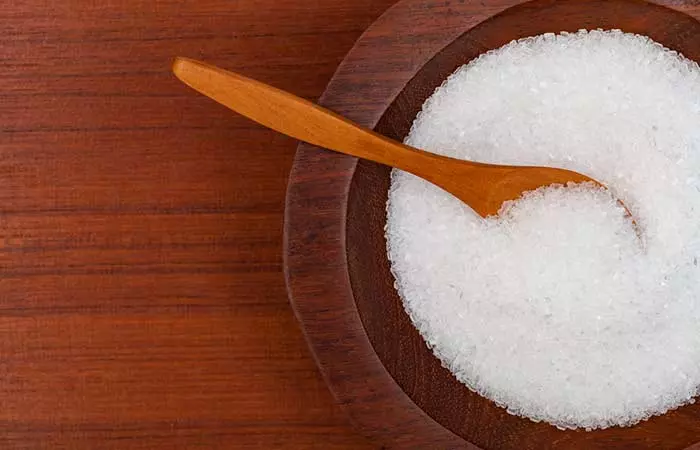
You Will Need
- 1 cup of Epsom salt
- Water
What You Have To Do
- Fill your bathtub with water.
- Add a cup of Epsom salt to it and allow it to dissolve.
- Soak in the Epsom salt bath for 15 to 20 minutes.
How Often You Should Do This
Do this at least once daily.
Why This Works
Epsom salt is also known as magnesium sulfate. The presence of magnesium helps reduce the inflammation and swelling of your tendons (1).
2. Apple Cider Vinegar
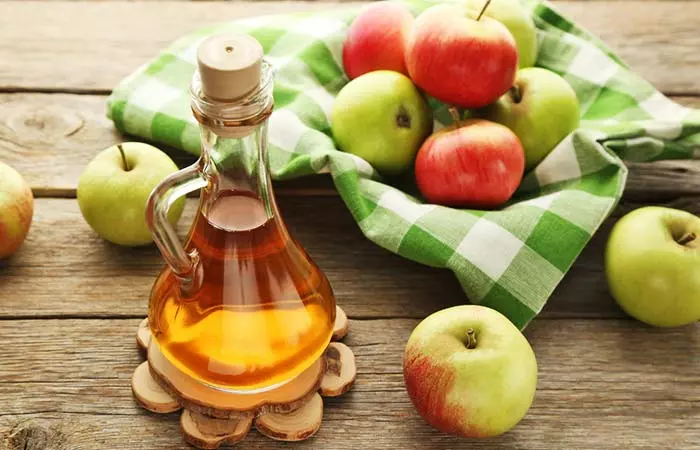
You Will Need
- ½ cup of raw apple cider vinegar
- ½ cup of warm water
- A clean washcloth
What You Have To Do
- Mix half a cup of apple cider vinegar with half a cup of warm water.
- Soak a clean washcloth in this mixture, wring it and place on the affected area surrounding the tendon. Leave it on for 20 to 30 minutes
- Remove the washcloth.
- You can also mix a tablespoon of apple cider vinegar in a glass of water and drink daily.
How Often You Should Do This
You can apply an apple cider vinegar compress thrice daily.
Why This Works
Apple cider vinegar has powerful anti-inflammatory properties due to the presence of acetic acid in it
. It can help reduce pain, swelling, and inflammation (2).
3. Ice Packs
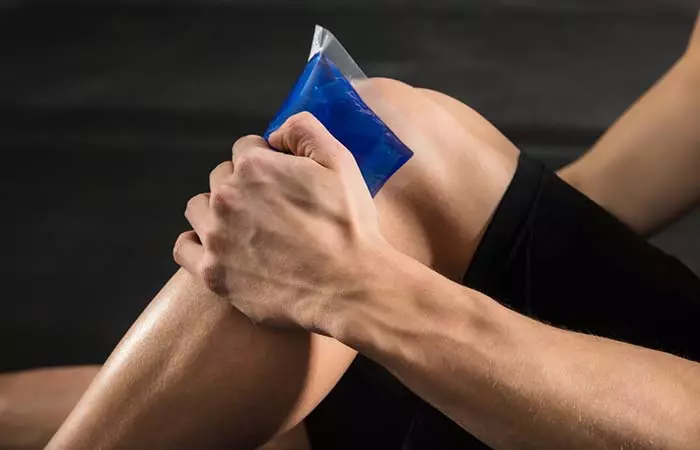
You Will Need
An ice pack
What You Have To Do
- Apply an ice pack close to the affected tendon.
- Leave it on for at least 10 minutes before taking it off.
How Often You Should Do This
Do this 2 to 3 times daily for best results.
Why This Works
An ice pack helps reduce symptoms of inflammation and swelling when applied topically. It also numbs the affected area and relieves pain (3).
4. Bone Broth
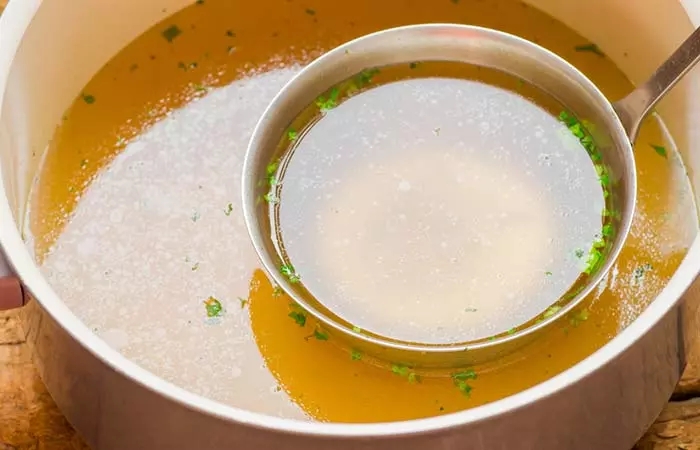
You Will Need
A bowl of freshly prepared bone broth
What You Have To Do
Consume a bowl of freshly prepared bone broth.
How Often You Should Do This
Have bone broth once daily.
Why This Works
Bone broth contains nutrients like glucosaminei A chemical compound found naturally in cartilage, a tough tissue that cushions joints and helps reduce friction during movement. and chondroitini A naturally occurring substance that forms the main component in the cartilage and prevents it from breaking down. that help in speeding the healing of your tendons (4).
5. Cayenne Pepper
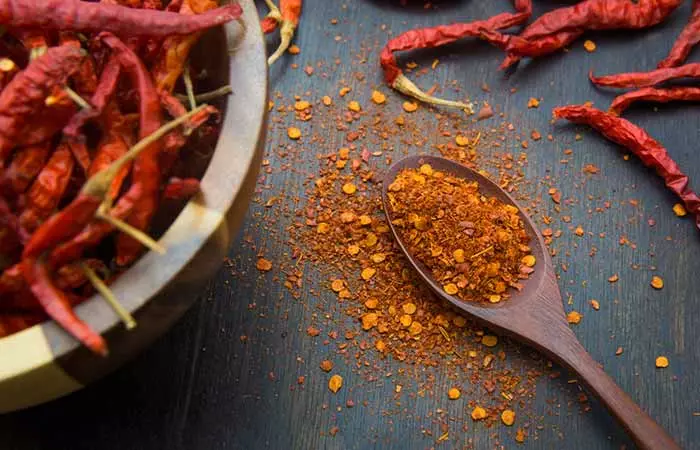
You Will Need
- 1 teaspoon of powdered cayenne pepper
- 2-3 teaspoons of olive oil
What You Have To Do
- To a teaspoon of cayenne pepper powder, add a few teaspoons of warmed olive oil.
- Massage this mixture gently onto the affected area.
- Leave it on for at least 30 minutes before washing it off.
- You can also mix a teaspoon of cayenne pepper in a glass of water and honey and drink daily.
How Often You Should Do This
You can apply cayenne pepper topically 2 to 3 times daily.
Why This Works
One of the main components of cayenne pepper is capsaicin. This compound exhibits analgesic activities that relieve pain and alleviate inflammation (5), (6).
6. Vitamin C

You Will Need
100-500 mg of vitamin C
What You Have To Do
Consume foods rich in vitamin C like citrus fruits, spinach, and kale or take additional supplements for it after consulting your doctor.
How Often You Should Do This
You must incorporate vitamin C into your daily diet.
Why This Works
Supplementation with vitamin C helps in speeding up the healing of inflamed tendons. This could be due to its anti-inflammatory properties as well as its ability to synthesize collageni A protein found in the connective tissue of the body that gives structural support to the tissues and repairs them. (7).
7. Ginger
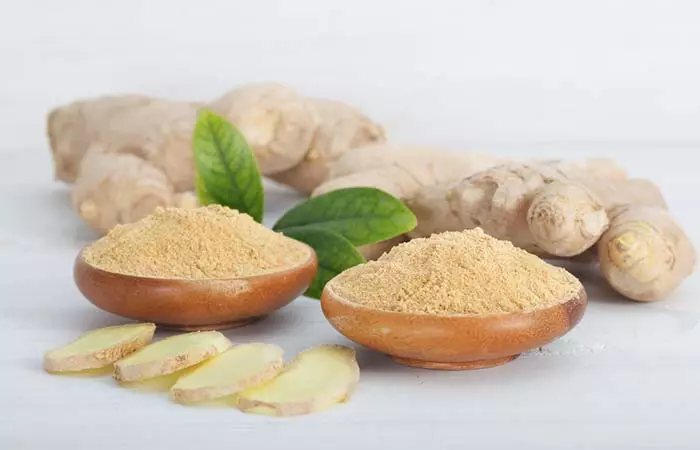
You Will Need
- 1-2 inches of ginger
- 1 cup of hot water
What You Have To Do
- Add 1 to 2 inches of ginger to a cup of hot water.
- Allow it to steep for 5 to 10 minutes.
- Drink the hot ginger tea.
- You can also soak a cloth in the ginger tea and apply it topically to the affected area.
How Often You Should Do This
Drink ginger tea twice daily for faster recovery from tendonitis.
Why This Works
Ginger is a herb that possesses powerful analgesic and anti-inflammatory properties due to the presence of gingeroli A chemical compound in ginger that stimulates the spice receptors on the tongue and contains anti-inflammatory and antioxidant properties. in it. These activities can help manage pain, inflammation, and other symptoms of tendonitis (8).
8. Castor Oil
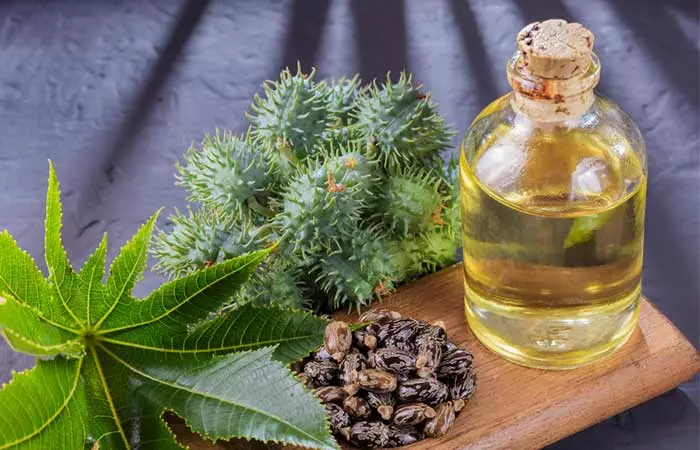
You Will Need
- 1 tablespoon of cold-compressed castor oil
- A warm compress
What You Have To Do
- Take a tablespoon of cold-compressed castor oil in your palms.
- Massage it gently around the affected tendon.
- Place a warm compress over it and leave it on for about 20 minutes.
- Remove the compress and rinse the oil off.
How Often You Should Do This
Do this twice daily.
Why This Works
Castor oil contains ricinoleic acid that possesses anti-inflammatory and analgesic properties that can help alleviate pain and inflammation (9).
 Quick Tip
Quick Tip9. Turmeric
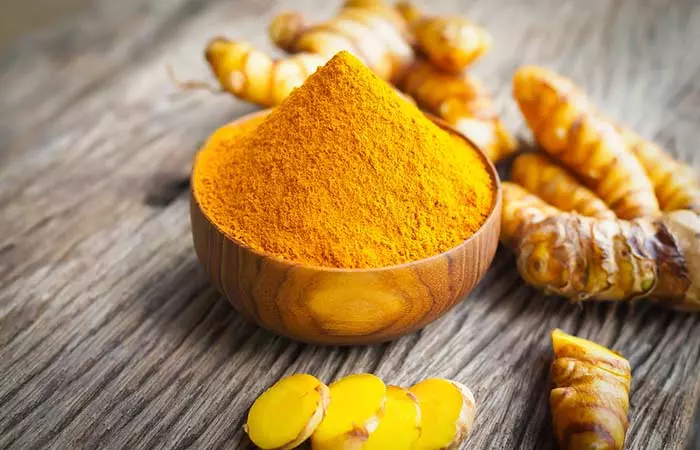
You Will Need
- 1 teaspoon of turmeric powder
- 1 glass of hot milk
What You Have To Do
- Add a teaspoon of turmeric powder to a glass of hot milk.
- Mix well and drink the concoction.
- You can also make a paste with turmeric powder and water and apply it to the affected area.
How Often You Should Do This
You can do this once daily.
Why This Works
Turmeric contains curcumin. Curcumin possesses anti-inflammatory and analgesic properties that can help in healing tendonitis and alleviating its symptoms (10), (11).
In addition to these natural treatments for tendonitis, there are some medical treatments available to alleviate the symptoms of this condition. They are discussed below.
Other Treatment Methods
Your doctor will first suggest you get enough rest and may even ask you to use ice packs
.
You may be prescribed painkillers like:
- Non-steroidal anti-inflammatory drugs (NSAIDs) like ibuprofen
- Corticosteroidi A term used for a class of hormones produced by humans as well as an anti-inflammatory medicine used to treat inflammation. injections
- Physical therapy that may involve massaging the affected area
Your physiotherapist may also help you with a personalized rehabilitation plan that includes exercises designed to enhance flexibility and build strength. These will eventually help you regain your normal movement patterns and prevent re-injury in the long run.
If your condition persists and there are also calcium deposits surrounding the tendon, you may have to avail shock wave therapy. You can also consider wearing a splint or brace.
Consider Wearing A Splint Or Brace
When dealing with tendonitis, wearing a splint or brace can be a valuable component of your treatment plan. These supportive devices aid in several ways:
- Immobilization: Limits the movement of the affected joint or tendon, allowing it to rest. Reduced movement minimizes strain on the inflamed area.
- Stability: Provides stability to the affected joint, reducing the risk of further injury or aggravating the existing one.
- Pain Relief: By restricting movement and stabilizing the tendon, it can alleviate pain and discomfort associated with tendonitis.
- Improved Healing: Supports the body’s natural healing processes and prevents further inflammation.
However, It’s crucial to consult with a healthcare professional for guidance on the appropriate type of splint or brace for your specific condition.
If your condition deteriorates because of leaving the affected tendon untreated for too long, causing the tendon to rupture, you may need to undergo surgery.
For a holistic recovery from tendonitis, you must pay extra attention to your diet as well.
Best Diet For Tendonitis
Foods To Eat
Foods that help tendonitis are mostly anti-inflammatory. They include:
- Vitamin C-rich foods like citrus fruits, green leafy vegetables, bell peppers, broccoli, and papaya
- Whole grains like brown rice, spelt, oats, and rye
- Omega-3i Fatty acids commonly found in the form of supplements that are needed to maintain a healthy body. -rich foods like fatty fish, walnuts, flaxseed, canola oil, and chia seeds
Foods To Avoid
Avoid these foods:
- Foods containing saturated fats like high-fat dairy and meat like lamb and steak
- Refined grains like white bread, white pasta, pretzels, and low-fiber cereals
- Foods containing free sugar like candies, soft drinks, and pastries
- Caffeine
- Alcohol
In addition to getting the right nutrition, following a few prevention tips may help avert the recurrence of the condition.
Prevention Tips
- Practice exercises that help in stretching and strengthening the muscles surrounding your tendon.
- Warming up before and cooling down after a strenuous workout is also important to prevent tendinitis.
- Avoid repeated use of an injured tendon.
- Avoid being in one position for too long.
- Give yourself ample rest so that your body works towards repairing your tendon.
- Opt for acupuncture to speed up your recovery.
- Ensure you maintain the correct form as you perform different activities like lifting weights or doing repetitive tasks to reduce strain on tendons.
- Use appropriate footwear and supportive braces if necessary to help reduce strain and prevent tendon injuries.
- Avoid sudden increases in workout intensity, as this can strain tendons. Build up strength and endurance gradually.
- If working in repetitive positions like at a desk throughout the day, ensure your setup is ergonomic to reduce strain on tendons.
Infographic: 9 Natural Remedies For Tendonitis
Remedies for minor cases of tendonitis are lying around us in abundance. If the pain is uncomfortable yet manageable, you can follow the above mentioned remedies and tips as a safer alternative to medicine to alleviate the symptoms. We have summarized the natural remedies for tendonitis in an infographic below for your future reference. Have a look and save it for later.

Illustration: StyleCraze Design Team
Tendonitis refers to an inflammation of the tendons and may occur due to repetitive strain on the tendons, injuries, or certain medical conditions like arthritis and gout. The most commonly affected body parts are the knee, elbow, hip, shoulder, the base of the thumb, and Achilles tendon. Besides pain and discomfort, you may notice symptoms like swelling, redness, and lumps along the tendon if you have developed tendonitis. Over-the-counter drugs and prescription medications are available for treating the pain. Still, you may also choose to apply natural treatments for tendonitis as plenty of home remedies are available. Epsom salt, apple cider vinegar, ice packs, bone broth, castor oil, turmeric, and cayenne pepper are some of the natural ingredients you can use to relieve pain and inflammation. Apart from these, leading a stress-free lifestyle and getting plenty of rest is important for the proper management of tendonitis. If pain persists or worsens, consult your medical provider to avoid delayed treatment.
Frequently Asked Questions
When to see a doctor for tendonitis?
See a doctor immediately if you experience recurring pain and/or swelling in the impacted area that does not subside despite rest or medications. This usually happens if you have ruptured your tendon.
What are the best essential oils for tendonitis?
Essential oils that are anti-inflammatory and analgesic can help a great deal in relieving tendonitis. A few such essential oils are lavender oil, peppermint oil, sweet marjoram oil, frankincense oil, helichrysum oil, lemongrass oil, and chamomile oil.
How painful is calcific tendonitis?
Calcific tendonitis is not of much concern unless the calcium deposits causing it to become inflamed or bigger. Calcium deposition mostly occurs in the muscles and tendons that surround your shoulder joints. Progression of this condition may have extremely painful results, and it is even capable of impairing your movement.
Does vitamin D help tendonitis?
Possibly. Vitamin D significantly contributes to the healing of tendon-to-bone injuries by boosting bone mineral density and fortifying the skeletal muscles (12).
Does CBD help with tendonitis?
Possibly. CBD is packed with anti-inflammatory and analgesic properties that may help soothe tendonitis (13).
Is tendonitis a form of arthritis?
No. Tendonitis is the inflammation of a tendon, whereas arthritis is the inflammation of a joint. While both disorders occasionally coexist, having one does not necessarily predispose you to develop the other.
Illustration: Natural Treatments For Tendonitis - Symptoms Causes And Diet Tips
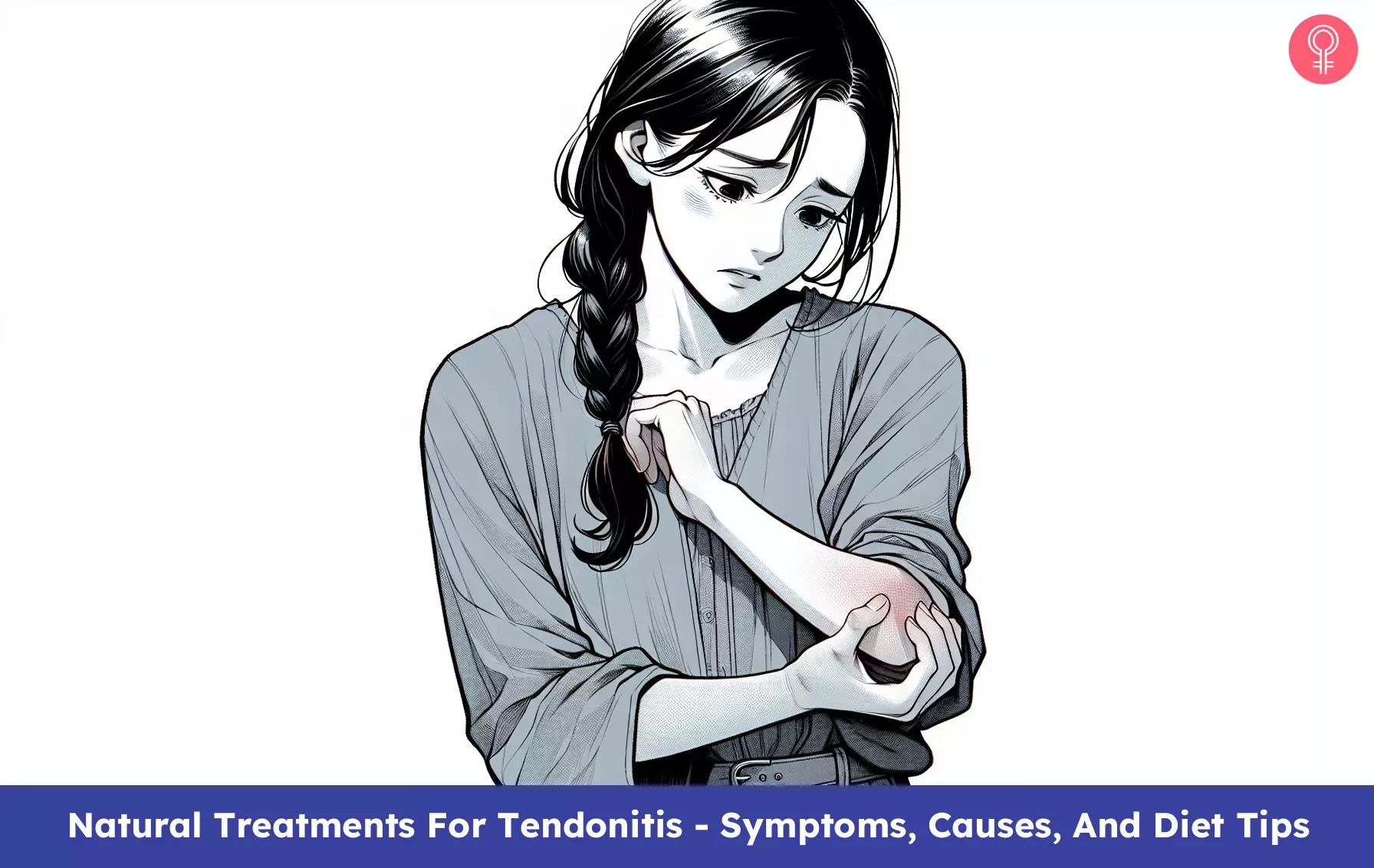
Image: Dall·E/StyleCraze Design Team
You can relieve the pain of tendonitis quite efficiently with some effective home remedies. Check out this video to know how to reduce tendonitis inflammation and get back to living pain-free.
Personal Experience: Source
StyleCraze's articles are interwoven with authentic personal narratives that provide depth and resonance to our content. Below are the sources of the personal accounts referenced in this article.
i. My Experience with Tendonitishttps://randyellefson.wordpress.com/2014/03/08/my-experience-with-tendonitis/
References
Articles on StyleCraze are backed by verified information from peer-reviewed and academic research papers, reputed organizations, research institutions, and medical associations to ensure accuracy and relevance. Read our editorial policy to learn more.
- “Magnesium Decreases Inflammatory Cytokine Production: A Novel Innate Immunomodulatory Mechanism”, Journal of Immunology, US National Library of Medicine
- “Anti-obesity and anti-inflammatory effects of synthetic acetic acid vinegar and Nipa vinegar on high-fat-diet-induced obese mice”, Scientific Reports, US National Library of Medicine
- “Effect of local cold-pack application on systemic anabolic and inflammatory response to sprint-interval training: a prospective comparative trial”, European Journal of Applied Physiology, US National Library of Medicine
- “Chondroitin Sulfate and Glucosamine Supplements in Osteoarthritis”, Arthritis Foundation
- “Topical capsaicin for pain management: therapeutic potential and mechanisms of action of the new high-concentration capsaicin 8% patch”, British Journal of Anaesthesia, US National Library of Medicine
- “Capsaicin exhibits anti-inflammatory property by inhibiting IkB-a degradation in LPS-stimulated peritoneal macrophages”, Cellular Signalling, US National Library of Medicine
- “High-dose vitamin C supplementation accelerates the Achilles tendon healing in healthy rats”, Archives of Orthopaedic and Trauma Surgery, US National Library of Medicine
- “Analgesic and anti-inflammatory activities of [6]-gingerol”, Journal of Ethnopharmacology, US National Library of Medicine
- “Effect of ricinoleic acid in acute and subchronic experimental models of inflammation”, Mediators of Inflammation, US National Library of Medicine
- “Anti-inflammatory properties of curcumin, a major constituent of Curcuma longa: a review of preclinical and clinical research”, Alternative Medicine Review, US National Library of Medicine
- “The comparison of preemptive analgesic effects of curcumin and diclofenac”, Bratislava Medical Journal, US National Library of Medicine
- “Vitamin D and the immunomodulation of rotator cuff injury”, Journal of Inflammation Research, US National Library of Medicine
- “Cannabidiol (CBD): a killer for inflammatory rheumatoid arthritis synovial fibroblasts”, Cell Death & Disease, US National Library of Medicine
Read full bio of Dr. Sudhansu Singh
Read full bio of Shaheen Naser
Read full bio of Arshiya Syeda
Read full bio of Dipti Sharma






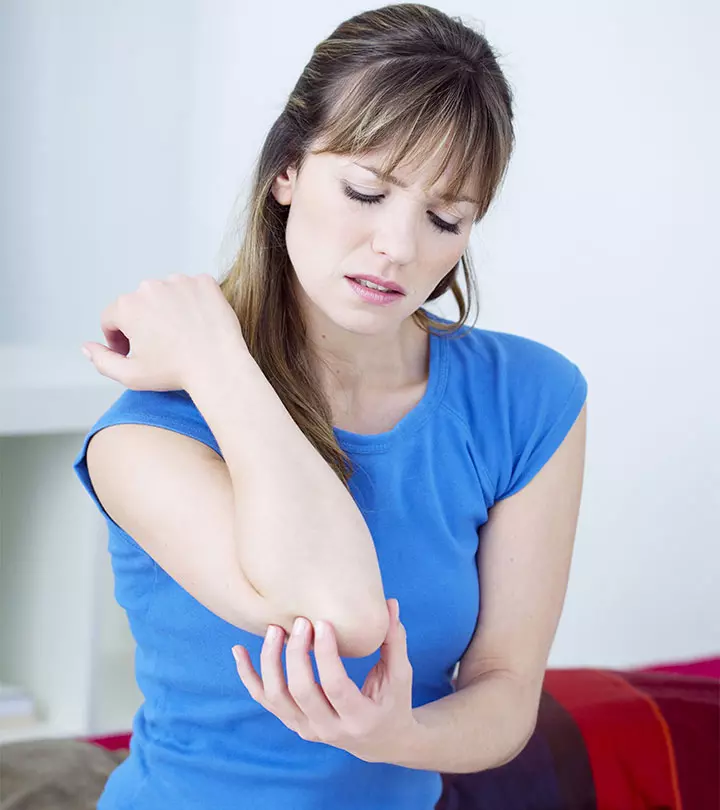

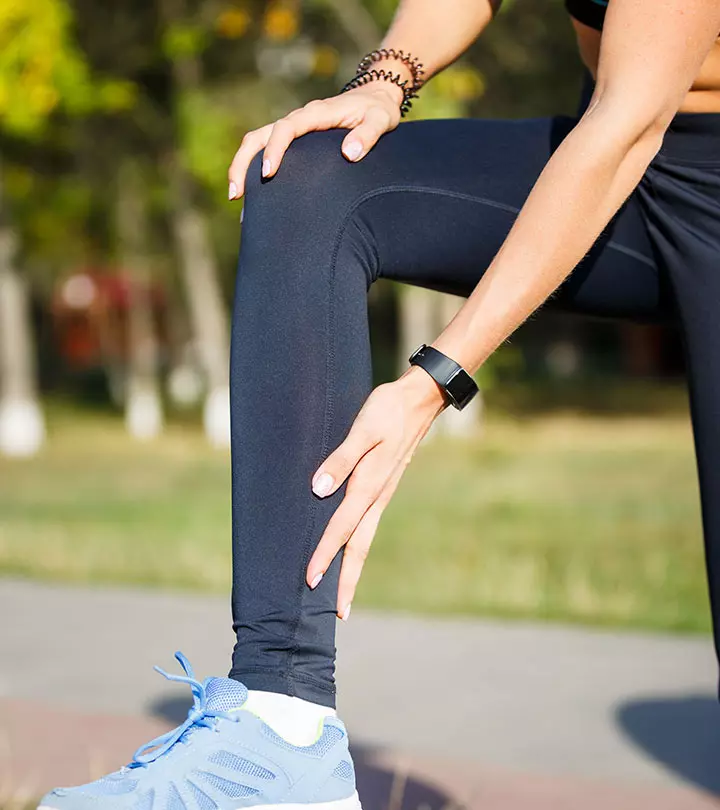


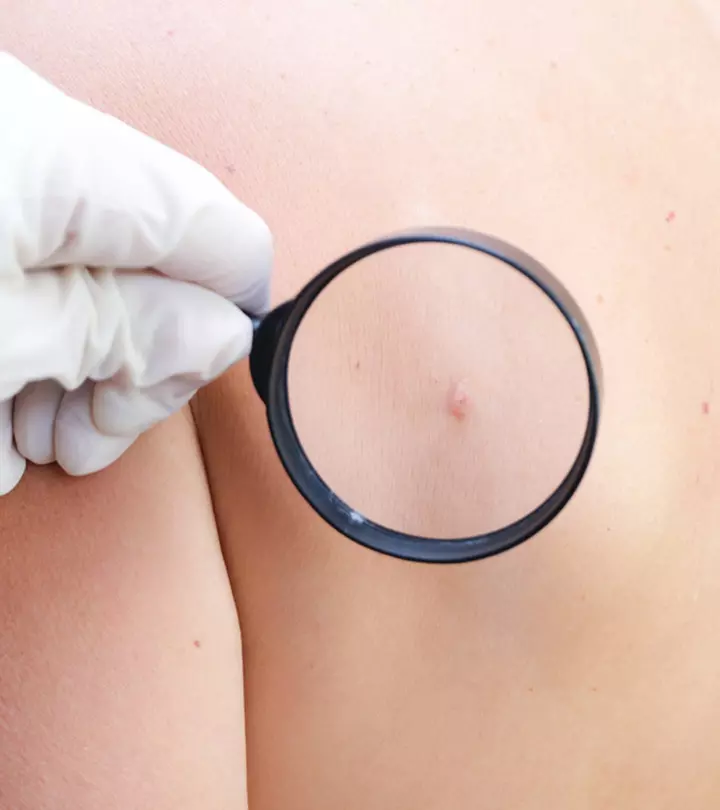
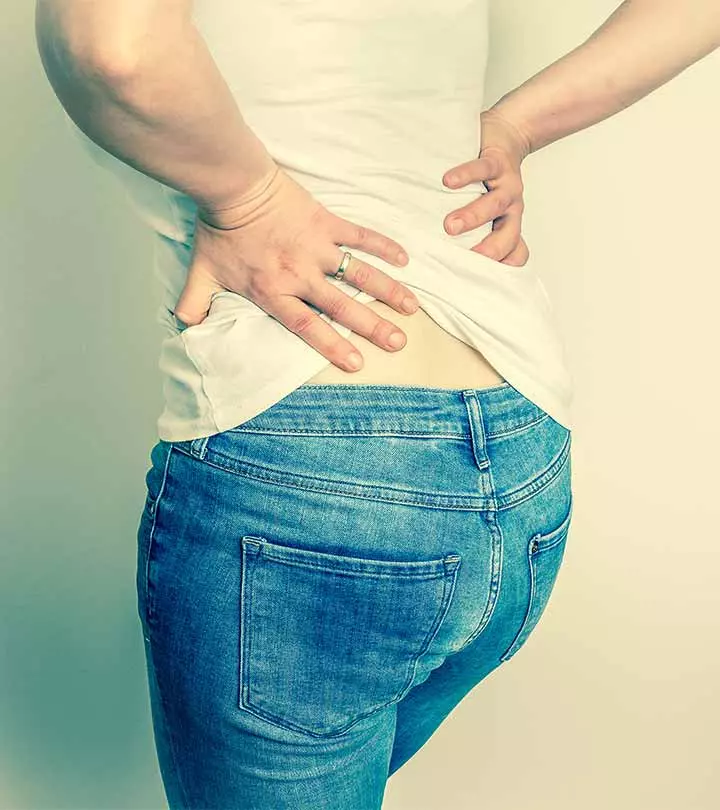

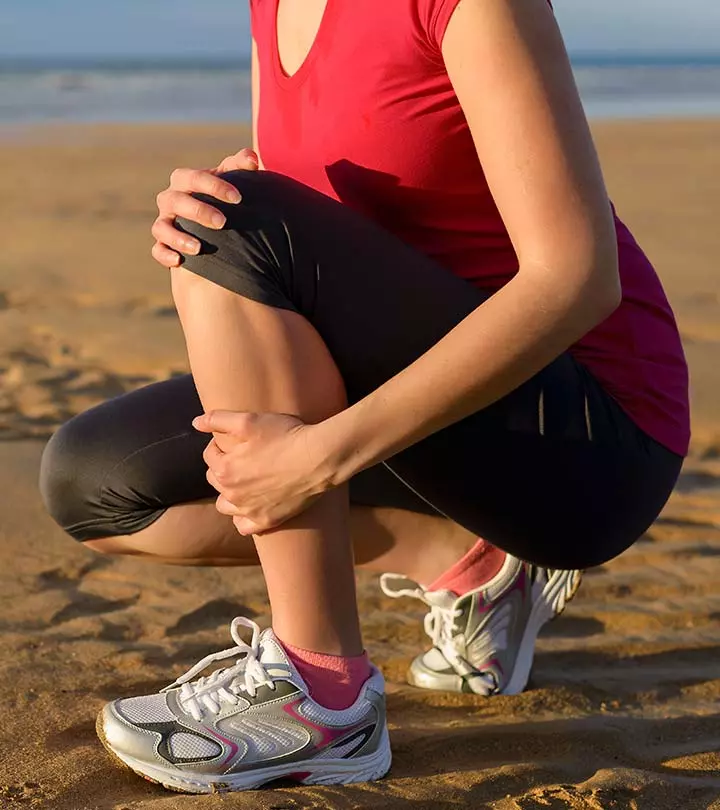

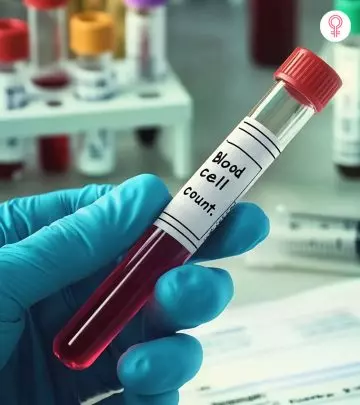


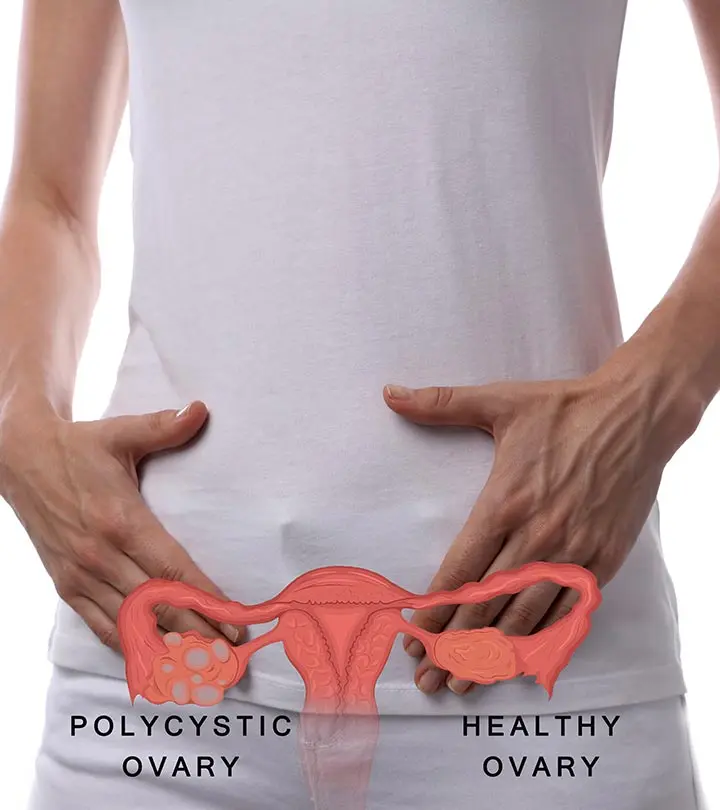


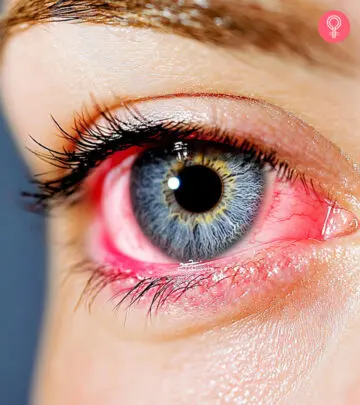

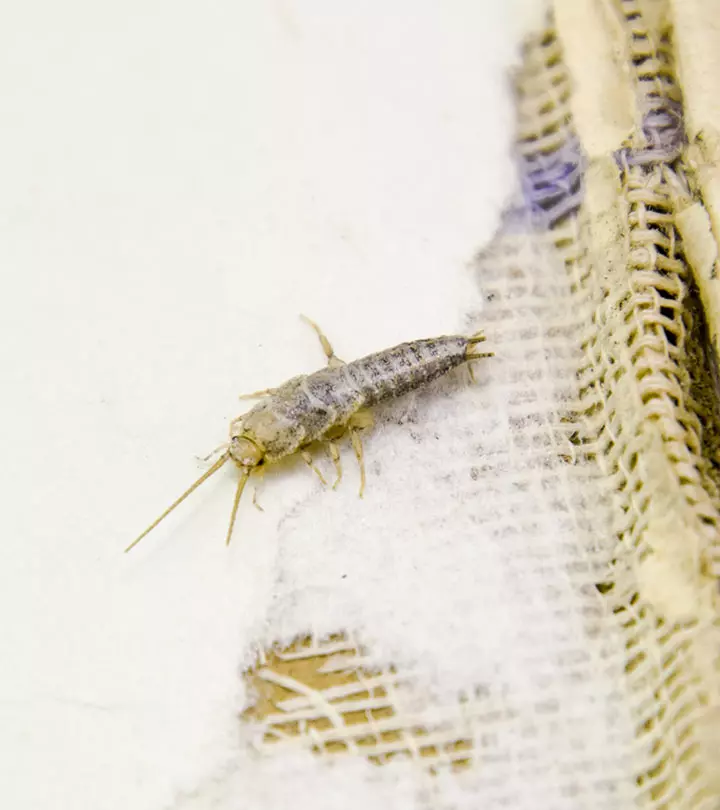

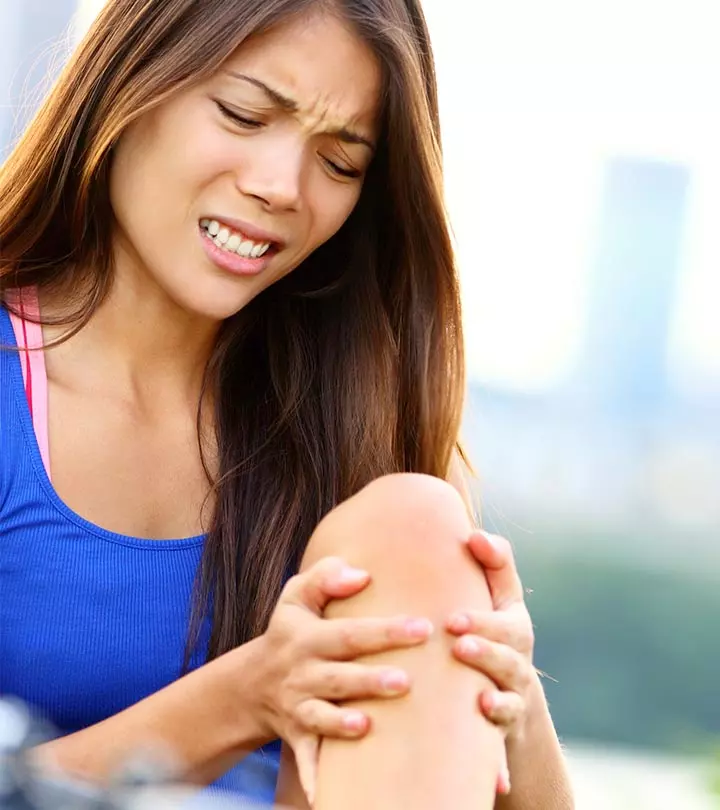
Community Experiences
Join the conversation and become a part of our empowering community! Share your stories, experiences, and insights to connect with other beauty, lifestyle, and health enthusiasts.